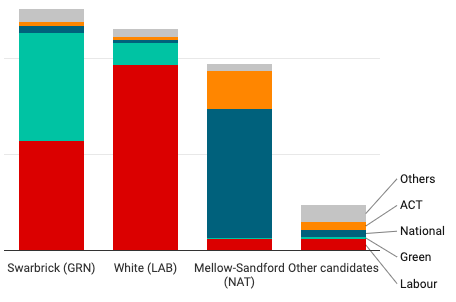New Zealand voters cast two votes, but (unlike in Australian federal elections) they are cast on a single piece of paper. This means it is possible to determine exactly how many voters who voted for each party on the list voted for a particular candidate in the electorate. This data was published for the 2020 election yesterday.
68% of all voters cast both votes for the same party. This ratio varied tremendously between the major parties and smaller parties. 87.6% of National party voters voted for a National electorate candidate, and 78% of Labour voters did the same. In contrast, only 29% of Green party voters and 21% of ACT party voters cast their electorate vote for the same party. Overall 81% of major party voters and 29% of other voters cast both their votes for the same party.
65% of ACT party voters cast their electorate vote for National, and 57% of Green party voters cast their electorate vote for Labour.
There are two seats I’m particularly interested in: the neighbouring inner-Auckland seats of Auckland Central and Epsom. Green MP Chloe Swarbrick won Auckland Central for the first time in 2020, while Epsom has been won by ACT MPs since 2005.
The National Party has traditionally given the go-ahead for their local voters in Epsom to defect and vote for ACT to ensure a partner for National in parliament. Jacinda Ardern was less than full-throated in her endorsement of the local Labour candidate in Auckland Central in 2020, but Labour didn’t sit out the race like National tries to do in Epsom.
I looked at the split vote statistics in Epsom in the lead-up to the 2014 election.
Back in 2011, a large number of Green and Labour voters cast their electorate vote for National, a tactic which could have potentially elected the National candidate, but they were thwarted thanks to the large numbers of National voters choosing to vote for the ACT candidate instead.
Labour and Green voters appear to have given up on pursuing this strategy. Just 16% of Green voters and 7% of Labour voters cast their electorate vote for National list MP Paul Goldsmith.
Almost 70% of National party voters in Epsom still cast their vote for ACT MP David Seymour, and they make up over half of his total vote. Almost 11,000 National party voters cast a ballot for Seymour, compared to just over 4,000 ACT party voters and 3469 Labour party voters.
Swarbrick also relied heavily on Labour party voters to win Auckland Central, although Labour’s voters were less emphatic in supporting her, which reflects Labour running a serious campaign to win this National-held seat.
34% of Labour’s party voters cast their electorate vote for Swarbrick, compared to 58% for Labour’s Helen White. Green party voters split 81-16 for Swarbrick over White.
Despite a majority of Labour voters sticking with White, Labour party voters still contributed more to Swarbrick’s total vote than Green party voters. She polled about 5754 votes from Labour party voters, compared to 5637 from Green party voters.
Meanwhile National candidate Emma Mellow-Sandford’s vote followed a similar pattern to National candidates across the country. She gained 88% of the National party vote, along with 72% of the ACT party vote, along with a handful of Labour voters.




Hi Ben,
Could you make graphs like that for every seat?
I could, but I won’t be doing so. The data is in separate spreadsheets for each seat and it takes some time for each one. You can look at the data yourself at the link above and it shouldn’t be hard to make similar charts in Excel. The only change I made to the data was to collapse a bunch of the columns/rows into an ‘other’ category on both the party vote and electorate vote dimension.
It would be quite interesting to see data like this in Australia, although it is impossible for the AEC to release data like this and completely impractical for anyone estimate the actual figures.
I’d be also be rather interested to see if Germany releases data similar to this at next years federal election. (New Zealand adopted this system from Germany)
In fact the results would probably see far more vote differentiation from constituency to party list on individual ballots, considering at least 3 if not 4 parties will receive 10%+ and a further 2 parties will most likely be elected elected crossing the 5% threshold.
Finally, unlike New Zealand regional variations are more pronounced in Germany. In the south the centre right parties and the Greens will have many voters splitting their votes. In the East many voters may split their constituency and list votes between the far right and far left for example.
Comments are closed.